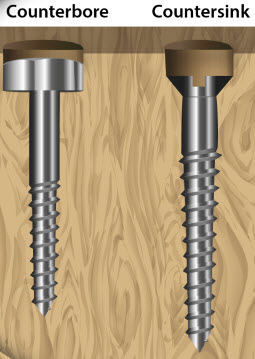
Have you come across counterbore screws? If so, you might be wondering how they differ from other types of screws. Like all screws, counterbore screws have a threaded exterior that becomes narrower towards the tip. You can drive them into wood or other materials using a screwdriver with the appropriate bit. Counterbore screws, however, are distinguished in several ways.
What Is a Counterbore Screw?
Counterbore screws are threaded fasteners that are designed for use in counterbored holes. A counterbored hole is essentially a pilot hole consisting of a long and narrow threaded channel at the bottom and a shallower but wider channel at the top. The latter channel supports the head of a counterbore screw.
If you inspect a counterbore screw, you’ll notice that it has a flat head. Both the top of the head and the bottom of the head are flat. This flat design allows them to sit flush when driven into a counterbored hole.
How Counterbore Screws Work
With their flat head, counterbore screws will sit flush with the surface of the object in which they are installed. Many applications require fasteners to sit flush. If a fastener isn’t flush, its head will protrude out of the surface. This can cause damage to either the fastener itself or the object. Counterbore screws offer a solution. They feature a flat head that fits perfectly within the top of a counterbored hole. You can drive a counterbore screw into a counterbored hole, and the head will stop once the screw becomes flush with the surface.
Counterbore vs Countersink Screws
There are also countersink screws. Countersink screws, as you may have guessed, are designed for use in countersunk holes. Countersunk holes are different from counterbored holes. They typically still have a narrow channel of threading. Instead of a flat bottom, though, they feature a conical shape. The top part of a countersink hole — the part in which the screw head enters and rests — is shaped like a cone. In other words, it becomes narrower towards the bottom. This conical shape matches the head of countersink screws.
Countersink screws are available in many of the same drive recesses as their counterbore counterparts. The difference between these two types of screws lies in their head. Counterbore screws have a flat head with an even and consistent diameter. Countersink screws, on the other hand, have a conical shape that’s wide at the top and narrow at the bottom.
No tags for this post.